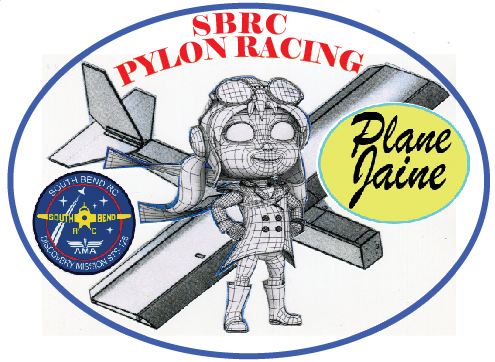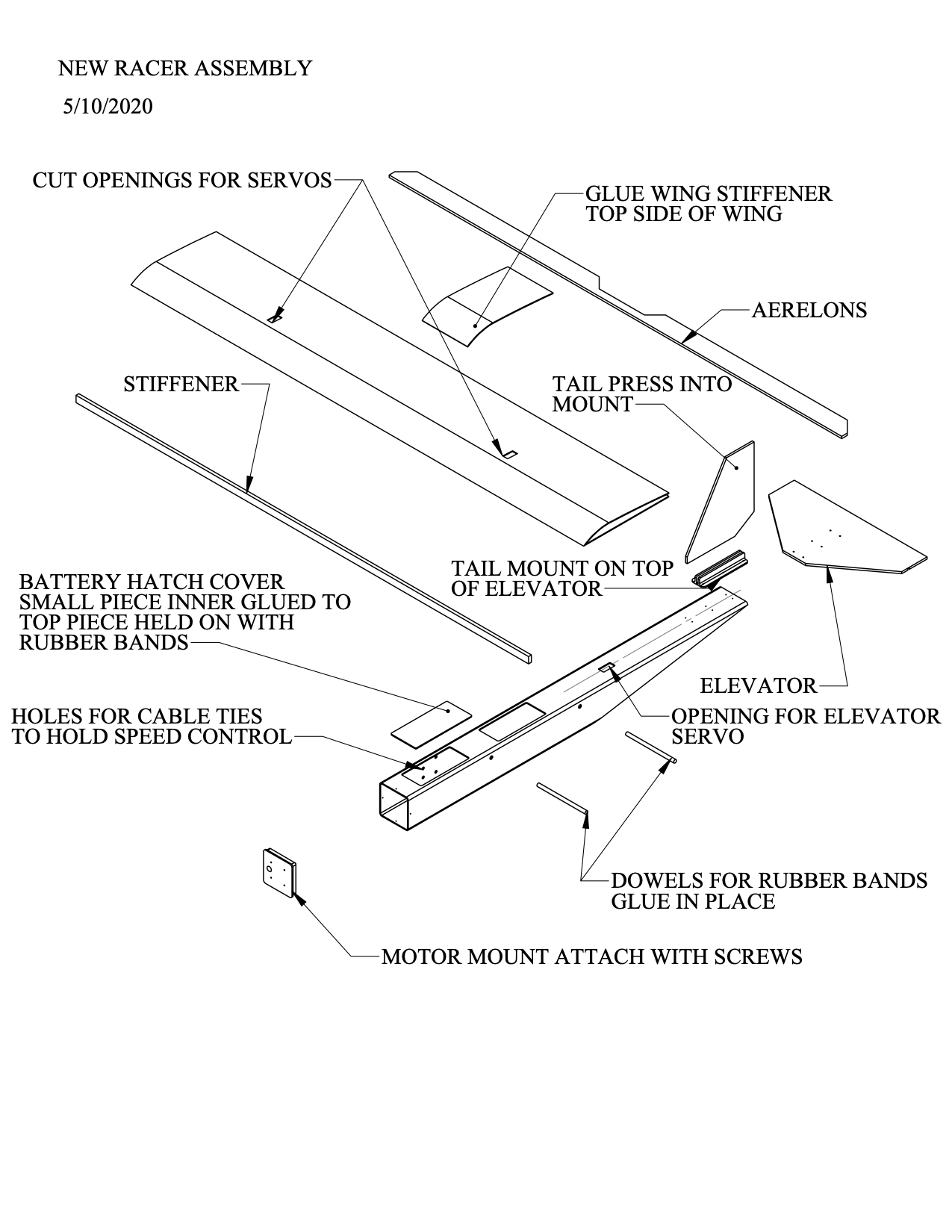Pylon racing
The South Bend Radio Control Club’s new pylon racer is called “PLANE JAINE” and was designed by John Conley based off of a Simple Plastic Airplane Design (SPAD). John’s creation has been turned into a kit by Paul Lashbrook. This new racer has a 40-inch wingspan, a 30-inch fuselage, powered by a DYS 3536 1450KV motor and will use 3S 2200mah (HV not permitted) batteries that many of us have in ready supply.
To purchase a pylon racer, simply contact Paul Lashbrook and indicate if you need a kit. Pricing information will be communicated as prices are subject to change due to the cost and availability of materials. We do everything we can to keep the prices as low as possible to support the racing efforts of the South Bend RC Club.


racing rules
Pilot Requirements:
- Open to any current SBRC Member
- New Pilots are welcome and encouraged to get involved anytime during the racing season
Race Heat; Procedural Steps:
- Starting Official announces competitors for the next heat.
- Starting Official announces “Pilots you are on the clock” and Pilots have 60 seconds to ready their plane and present themselves at the starting line.
- Starts, either by Hand or Launcher, are simultaneously launched toward pylon #1.
- Starting Official will call for a launch by sounding a horn when: All Pilots are at the starting line and each has indicated to the Starting Official that he/she is ready for launch – or 60 seconds have elapsed since the Starting Official had announced ‘on the clock ‘, whichever comes first.
- Starting Official will announces “Are you ready?” then count to 1,2,3 and sounding a horn to get the heat started.
- A Pilot may launch his/her plane after the official start provided at least one previously launched aircraft has yet to complete (10) laps.
- At the completion of (10) laps, the Pilot will land his/ her aircraft as quickly as practical, even if others are completing their (10) race laps.
- No Pilot or Counter may leave the Pilot position until all aircraft have landed.
- After the last Competitor has completed his/her race, all Pilots will expeditiously retrieve their aircraft and clear the field.
Pilots for the next heat will expeditiously take the field, with their aircraft prepared for flight.
Counters will communicate with the Official Scorer the finishing order, Judges will communicate cuts and dead lines.
Judges and Judging:
- Judges will be positioned behind the dead line at pylon #1 and pylon #2 perpendicular with the pylons.
- Three Counters assigned, 1 per plane, will count 10 laps by sounding a horn.
- Judges at pylons #1 and #2 will monitor all aircraft for dead line faults.
- The official Score Keeper will keep a record of that days’ heats for which the race director(s) will keep & maintain.
Aircraft Introduction & Directives:
- “PLANE JAINE” only.
- Colors must be registered ( trensber@gmail.com )
- Aileron, Elevator & Throttle control only (no rudder)
- Closing of flute edges is permitted.
- Location & attachment of Electronics are builders choice
- Motor: 3536 1450KV motor.
- Battery: Maximum, 11.1V, 2200mAh (HV not permitted) Mounted per Builder’s Choice
- ESC: up to 50 Amp
- Servos: Builder’s Choice (1 per aileron, 1 for elevator. Total of 3 servos)
- Propellor: 9×4.5
Safety on the Race Course:
- Only Pilots, Pilot‘s Counters, and the Starting Official are allowed on the field during a race. All other Pilots and spectators must be behind the ‘dead line’ .
- Pilots and Counters must remain in the Pilot position until all aircraft have landed.
- Any member of the Race Committee or any Judge may black flag any aircraft that becomes erratic or appears dangerous in flight. The Pilot must immediately land a black-flagged aircraft.
- Pilots are expected to visually check the operation of all control surfaces but prior to launch.
- No aircraft is to be flown beyond the ‘dead line’ at any time. Any aircraft flown over the ‘dead line’ is immediately disqualified. Only Judges are to make this call.
Race Course:
- South Bend RC Flying Field
- Visit our Website…. southbendrc.org
- (2) pylon poles, 300 ft apart.
- Pylon # 1 is the West Pylon
- A race consists of (10) laps counterclockwise.
- Launch per Race Director
- Pilots fly outside of Course
Scoring:
- Judges note if any aircraft cut inside any pylon and count cuts for each aircraft.
- Heat points are awarded as follows: First place – 4 points, Second place – 3 points, Third place – 2 points, No points are awarded if the aircraft did not complete 10 laps.
- Penalties for cuts: 1 cut – only 1 point awarded regardless of finishing position; remaining Pilots finishing position and score increased, 2 or more cuts, 0 points awarded regardless of finishing position; remaining Pilots finishing position and score increased. Example 1: Racer A finishes first with one cut, B finishes second with no cuts, C finishes third with no cuts. Racer A gets 1 point, B gets 4 points, and C gets 3 points.
Example 2: Racer A finishes first with no cuts, B finishes second with two (or more) cuts, C finishes third with no cuts. Racer A gets 4 points, B gets 0 points, C gets 3 points. - Race Day Winners: The three Pilots with the highest point accumulation of the day (three heats) will receive awards for the day. Ties will be determined by a 10 lap fly-off or coin flip, by the mutual agreement of the Pilots
- Season Winners: There are six scheduled races; season point totals will be determined by a Pilot’s five best race days. The three Pilots receiving the most points for the season will be awarded trophies.
- Ties: (1) The higher trophy will be awarded to the Pilot with the most accumulated points in the races in which the two tied Pilots raced against each other. (2) If a tie still exists, the higher trophy will be awarded to the Pilot with the most points in all eight races. (3) If a tie still exists, two special trophies of equal rank will be awarded to both Pilots.
Race Preparations; procedural steps:
- The racecourse is set up with respect to the wind so far as is practical and with respect to AMA guidelines for distances from the racecourse to the Judges and pits.
- Sign in of Competitors, payment of fees.
- At this time, Race Aircraft, including Backup Race Aircraft, must be declared and weighed in. Any pre-race testing must be completed prior to the start of racing.
- All Competitors and Judges must sign the “Liability Waiver” which will be kept in a permanent file
- Establish the race matrix
- Heat matrix copied to Starter’s board and Racer’s board.
- Race Director to hold pre-race Pilot’s briefing and safety meeting.
- Pilots to remain behind the designated flight line.
